14.02.2020

On Feb. 11, 2020, Mars 2020 Assembly, Test and Launch Operations Manager David Gruel watched as members of his team loaded NASA's next Mars rover onto an Air Force C-17 at March Air Reserve Base in Riverside, California. The rover was flown to Cape Canaveral, Florida, in preparation for its July launch. Credit: NASA/JPL-Caltech
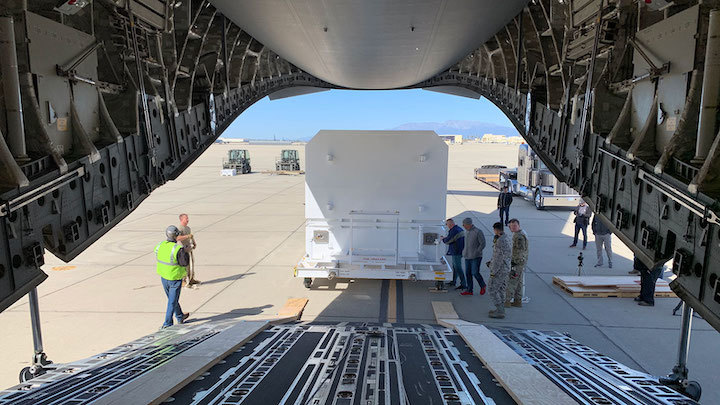
The shipping container carrying NASA's Mars 2020 rover is readied for loading aboard an Air Force C-17 transport plane at March Air Reserve Base in Riverside, California, on Feb. 11, 2020.Image Credit: NASA/JPL-Caltech
-
The agency's first step in returning rocks from Mars just arrived at Kennedy Space Center. The Mars 2020 team now begins readying for a launch to the Red Planet this July.
NASA's next Mars rover has arrived in Florida to begin final preparations for its launch to the Red Planet this July. Two Air Force C-17 Globemaster cargo planes carrying the Mars 2020 rover as well as the cruise stage, descent stage and Mars Helicopter touched down at NASA's Kennedy Space Center at about 3 p.m. EST (12 p.m. PST) today, completing a 2,300-mile (3,700-kilometer) trip that began yesterday at NASA's Jet Propulsion Laboratory in Pasadena, California.
"Our rover has left the only home it has ever known," said John McNamee, Mars 2020 project manager. "The 2020 family here at JPL is a little sad to see it go, but we're even more proud knowing that the next time our rover takes to the skies, it will be headed to Mars."
Assembly, test and launch operations for Mars 2020 began in January 2018. The first piece of hardware that would become part of the rover arrived on the clean room floor of JPL's Spacecraft Assembly Facility's High Bay 1 a few months later.
The rover's aeroshell - its protective covering for the trip to the Red Planet - arrived at Kennedy this past December. Early on Feb. 11, the rover, cruise stage, descent stage and mission support equipment headed in four police-escorted trucks to the U.S. Air Force's March Air Reserve Base, where they were loaded aboard the two waiting C-17s.
Within hours of arriving at the Shuttle Landing Facility at Kennedy Space Center, the 11 pallets of Mars 2020 spacecraft will be transported to the same spacecraft processing facility that in 2011 handled NASA's Curiosity rover, which is currently exploring Mars' Gale Crater. Later this week, the Mars 2020 assembly, test and launch operations team will begin testing the components to assess their health following the cross-country flight.
After months of final assembly and additional testing, Mars 2020 should be enclosed in its aeroshell for the final time in late June. It will be delivered to Cape Canaveral Air Force Station's Launch Complex 41 to be integrated with the United Launch Alliance Atlas V rocket that will hurl it toward Jezero Crater in early July.
Mars 2020 will collect and store rock and soil samples in sealed tubes and will search for signs of past microbial life, characterize the planet's climate and geology, and pave the way for human exploration. Subsequent missions, currently in the planning stages, will return to Jezero Crater, gather the samples collected by Mars 2020 and return them to Earth for the sort of in-depth study that only a full-size lab can provide.
JPL is building and will manage operations of the Mars 2020 rover for NASA. NASA's Launch Services Program, based at the agency's Kennedy Space Center in Florida, is responsible for launch management.
Quelle: NASA
----
Update: 19.02.2020
.
Nasa's 2020 rover: Can we finally answer the big question about Mars?
Exactly a year from now, a capsule will come hurtling through the atmosphere of Mars with the Americans' next big rover. If it survives the "seven minutes of terror" that describe its descent to the surface, the new robot promises a very different mission to all those that have gone before it.
Because although Mars 2020 (a new name is coming) looks like a simple copy of the Curiosity vehicle of 2012, its goals take a decisive turn towards answering the most fundamental of questions: is there - or has there ever been - life on the Red Planet?
Recent investigations have concentrated on characterising the "habitability" of Mars.
That's to say, these prior missions asked only if past conditions were conducive to biology. A less direct approach.
Mars 2020, on the other hand, will be engaged in an explicit hunt for life's traces.

Undeniably it'll be a difficult quest. Evidence for life on the early Earth always attracts a degree of scepticism, even controversy, and laboratory equipment the size of a large room is often required to back up a claim.
So how will people react if a rover finds something intriguing imprinted in billions-of-years-old rock on another planet?
2020 mission scientist Jim Bell from Arizona State University is candid in his response: "We can make a claim about a biosignature, but it's not clear to me anyone would believe us," he said.
"So, let's bring the samples back. So if those extraordinary claims are made, they can be verified."
This then is the strategy for Mars 2020: Find something remarkable and cache it for later return to one of those big Earth laboratories.
 Image copyrightNASA/JPL-CALTECH
Image copyrightNASA/JPL-CALTECH
The rover will trundle across equatorial Jezero Crater seeking out rocks that look as though they might have been laid down in the presence of biology.
The best examples will be drilled and sealed in small tubes the size of whiteboard markers. These canisters will then be placed on the surface for a later mission to pick up and take home.
But what would putative biosignatures look like?
A good example, says Katie Stack Morgan, might be remnants of finely layered, dome-like structures associated with ancient communities of microbes. On Earth we know such structures as stromatolites, which form at the edges of salty lakes and lagoons.
It's all about recognising tell-tale patterns, textures, and chemical compositions, the deputy project scientist told BBC News: "What [these microbes] leave behind in the rock record are very thin layers, but with concentrations of particular elements or organics at those repeated intervals that represent the ancient fossilised microbial mat. So as those mats grow, they basically form the rock. And so we're looking for those fine laminations with concentrations of organics or certain elements that wouldn't be expected if these things were just abiotic, or didn't involve life."
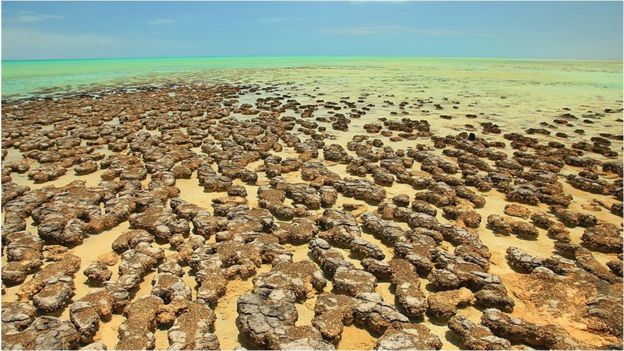 Image copyrightGETTY IMAGES
Image copyrightGETTY IMAGES
When Curiosity landed in Gale Crater in 2012, scientists were uncertain about its history, how the mountain at its centre formed and what sort of influence water may have played in the evolution of the deep depression.
Jezero carries far more certainty. Satellite pictures clearly illustrate the outline of a once great lake and the delta that fed it.
Enticing is the sliver of carbonate rocks that seem to mark what would have been the palaeo-lake's shoreline.
"When we think of carbonates on Earth, we think of reefs and we think of shallow warm water," said Dr Stack Morgan.
"We don't know that we're going to find reefs on Mars but we do think with these shallow waters where carbonates were precipitated, it could be that we had organisms that were making use of that carbonate just like we have here on Earth in shallow water environments."
Curiosity has astonished us with its discoveries of river-worn pebbles and lake muds that point to periods of abundant water moving across Mars early in its history.
But the veteran rover's instrumentation - frustratingly - can only grasp a coarse, or bulk, view of the chemistry that persisted at the time. It must crush up its samples before testing them. 2020, alternatively, will carry instruments that will be able to examine a rock's fine-scale textures while at the same time mapping the detailed elemental distribution within those textures.
 Image copyrightNASA/JPL-CALTECH
Image copyrightNASA/JPL-CALTECH
Indeed, everything about Mars 2020 should be regarded as a step up on what's gone before, believes Dr Bell.
The Arizona scientist is leading on the main camera system that sits atop the rover's mast.
"They look like the MastCams on Curiosity; they're in the same place. But unlike the Curiosity cameras, ours will zoom from wideangle all the way to telephoto. So, we'll collect a lot more stereo and 3D data. All that was possible with Curiosity, but it was a little more cumbersome.
"We also have microphones. We're hopeful that we'll be able to capture some of the sounds of entry, descent and landing; and some of the sounds of driving around, merging that sound with the video that we can take."
The rover has recently arrived at Nasa's Kennedy Space Center in Florida to begin its final preparations for launch. This will take place between 17 July and 5 August.
It's a seven-month cruise to the Red Planet.
Engineers have targeted a touchdown for shortly after 20:30 GMT on Thursday, 18 February, 2021.
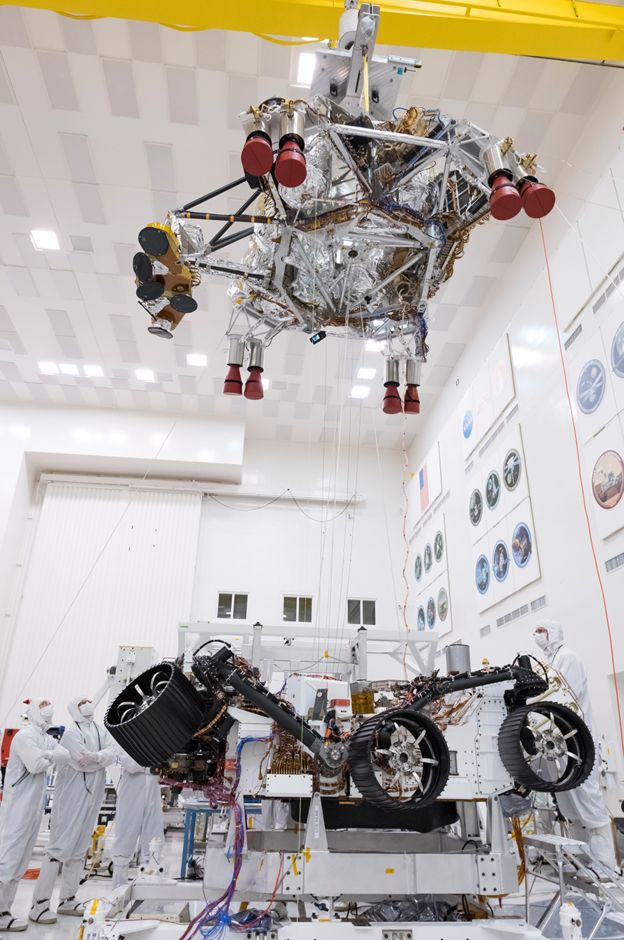 Image copyrightNASA/JPL-CALTECH
Image copyrightNASA/JPL-CALTECH
NASA Adds Return Sample Scientists to Mars 2020 Leadership Team

The leadership council for Mars 2020 science added two new members who represent the interests of scientists destined to handle and study the first samples from Red Planet.
In the fall of 2019, the Mars 2020 rover team welcomed ten members to serve as Returned Sample Science Participating Scientists. Scheduled to launch in July 2020 as NASA's next step in exploration of the Red Planet, the Mars 2020 mission will search for signs of past microbial life, characterizing the planet's climate and geology, and will be the first planetary mission to collect and cache Martian rock core and dust samples. Subsequent missions, currently under consideration by NASA (in conjunction with the European Space Agency), would send spacecraft to Mars to collect these cached samples from the surface and return them to Earth for in-depth analysis.
NASA recentlyselected two of these Returned Sample Science Participating Scientists to join the Mars 2020 Project Science Group (PSG). As the leadership council that helps define and refine science goals and strategies of the Mars 2020 mission, the project science group coordinates the scientists involved with the Mars rover project. With the new position, Chris Herd from the University of Alberta in Edmonton, Canada, and Tanja Bosak from the Massachusetts Institute of Technology in Cambridge will represent the interests of scientists destined to handle and study the first samples from Mars.
Collecting samples from Mars and bringing them back to Earth is a historic undertaking that starts with the launch of NASA's Mars 2020 rover. The rover will collect samples and leave them ready for a future mission to retrieve and return to Earth. That future mission involves the collaboration of NASA with the European Space Agency.
"Our Returned Sample Science Participating Scientists must anticipate the needs of future investigators who will analyze these first Mars samples for a very diverse range of studies in Earth-based laboratories," said Mars 2020 Project Scientist Ken Farley, who is based at Caltech in Pasadena, California. "Chris and Tanja's appointment to the Mars 2020 PSG highlights the importance we place on the role of these scientists and that of sample return. They are speaking for history's first scientists to handle samples from another planet - many of whom at present are probably still in high school."
Herd and Bosak and the eight other Returned Sample Science Participating Scientists have hit the ground running since joining the Mars 2020 science team in the fall of 2019, working on research projects and contributing to mission planning. Things will accelerate for the 2020 team as a whole after the rover launches from Cape Canaveral Florida this July. And things will really kick into high gear after the Mars 2020 rover touches down at Mars' Jezero Crater on Feb. 18, 2021.
Quelle: NASA
----
Update: 28.03.2020
.
10.9 Million Names Now Aboard NASA's Perseverance Mars Rover

NASA's "Send Your Name to Mars" campaign invited people around the world to submit their names to ride aboard the agency's next rover to the Red Planet. Some 10,932,295 people did just that. The names were stenciled by electron beam onto three fingernail-sized silicon chips, along with the essays of the 155 finalists in NASA's "Name the Rover" contest. The chips were then were attached to an aluminum plate on NASA's Perseverance Mars rover at Kennedy Space Center in Florida on March 16. Scheduled to launch this summer, Perseverance will land at Jezero Crater on Feb. 18, 2021.
The three chips share space on the anodized plate with a laser-etched graphic depicting Earth and Mars joined by the star that gives light to both. While commemorating the rover that connects the two worlds, the simple illustration also pays tribute to the elegant line art of the plaques aboard the Pioneer spacecraft and golden records carried by Voyagers 1 and 2. Affixed to the center of the rover's aft crossbeam, the plate will be visible to cameras on Perseverance's mast.
Currently, the coronavirus has not impacted the Mars Perseverance rover launch schedule. The installation was one of numerous recent activities performed by the Perseverance assembly, test and launch operations team. On March 21, the team began reconfiguring the rover so it can ride atop the Atlas V rocket. Steps included stowing the robotic arm, lowering and locking in place the remote sensing mast and high-gain antenna, and retracting its legs and wheels.

The Perseverance rover is a robotic scientist weighing just under 2,300 pounds (1,043 kilograms). It will search for signs of past microbial life, characterize Mars' climate and geology, collect samples for future return to Earth, and help pave the way for human exploration of the Red Planet.
JPL, a division of Caltech in Pasadena, is building and will manage operations of the Mars Perseverance rover for NASA. The agency's Launch Services Program, based at the agency's Kennedy Space Center in Florida, is responsible for launch management. The Mars 2020 project with its Perseverance rover is part of a larger program that includes missions to the Moon as a way to prepare for human exploration of the Red Planet. Charged with returning astronauts to the Moon by 2024, NASA will establish a sustained human presence on and around the Moon by 2028 through NASA's Artemis lunar exploration plans.
Quelle: NASA
+++
Names of CENAP, H.Köhler Now Aboard NASA's Perseverance Mars Rover



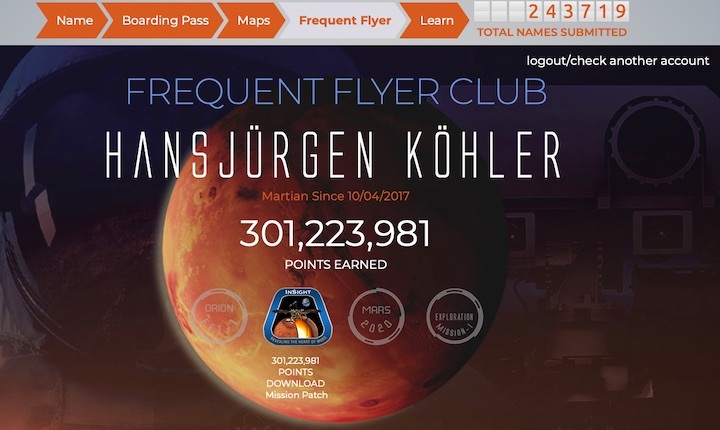


Quelle: NASA
----
Update: 31.03.2020
.
NASA Shows Perseverance with Helicopter, Cruise Stage Testing

By Jim Cawley
NASA's Kennedy Space Center
The Mars 2020 mission involving NASA’s newly named rover — Perseverance — received a significant boost following the completion of important testing at the agency’s Kennedy Space Center in Florida.
Activities to measure mass properties of the Cruise Stage vehicle were performed on the spin table inside the Payload Hazardous Servicing Facility. Successful testing also was performed on NASA’s Mars Helicopter, which will be attached to Perseverance. The functional test (50 RPM spin) was executed on the stand in the airlock. This marked the last time the rotor blades will be operated until the rover reaches the Martian surface.
The NASA Mars Helicopter will be the first aircraft to fly on another planet. The twin-rotor, solar-powered helicopter will remain encapsulated after landing, deploying once mission managers determine an acceptable area to conduct test flights.
On March 5, 2020, NASA announced Perseverance as the new name for the Mars 2020 rover. Alexander Mather, a seventh-grader from Virginia, provided the winning name for the rover with his entry in the agency’s Name the Roveressay contest.
Perseverance will land on the Red Planet on Feb. 18, 2021. Liftoff aboard a United Launch Alliance Atlas V 541 rocket is targeted for mid-July from Cape Canaveral Air Force Station. NASA’s Launch Services Program based at Kennedy is managing the launch.
About the size of a car with dimensions similar to the Curiosity rover, Perseverance was developed under NASA’s Mars Exploration Program. The mission aims to search for signs of past microbial life, characterize the planet’s climate and geology, collect samples for future return to Earth and pave the way for human exploration of Mars.
Quelle: NASA
----
Update: 2.04.2020
.
The Man Who Wanted to Fly on Mars

Mars Helicopter's chief engineer Bob Balaram and the Mars Helicopter on a test stand. The technology demonstration will ride aboard NASA's Perseverance rover to the Red Planet. Credit: NASA/JPL-Caltech
The Mars Helicopter is riding to the Red Planet this summer with NASA's Perseverance rover. The helicopter's chief engineer, Bob Balaram, shares the saga of how it came into being.
Even before this interviewer can finish the question, "Did anyone ever tell you this was a crazy idea?" Bob Balaram jumps in: "Everyone. All the time."
This "crazy idea" is the Mars Helicopter, currently at Kennedy Space Center waiting to hitch a ride to the Red Planet on the Mars Perseverance rover this summer.
Although Balaram probably didn't know it at the time, the seed for an idea like this sprouted for him in the 1960s Apollo era, during his childhood in south India. His uncle wrote to the U.S. Consulate, asking for information about NASA and space exploration. The bulging envelope they sent back, stuffed with glossy booklets, entranced young Bob. His interest in space was piqued further by listening to the Moon landing on the radio. "I gobbled it up," he says. "Long before the internet, the U.S. had good outreach. You had my eyeballs."
His active brain and fertile imagination focused on getting an education, which would lead him to a bachelor's degree in mechanical engineering from the Indian Institute of Technology, a master's and Ph.D. in computer and systems engineering from Rensselaer Polytechnic Institute, and a career at NASA's Jet Propulsion Laboratory in Southern California. That's where he has remained for 35 years as a robotics technologist.
Balaram's career has encompassed robotic arms, early Mars rovers, technology for a notional balloon mission to explore Venus and a stint as lead for the Mars Science Laboratory entry, descent and landing simulation software.
Cutting Through Obstacles, Red Tape and the Martian Atmosphere
As with many innovative ideas, it took a village to make the helicopter happen. In the 1990s, Balaram attended a professional conference, where Stanford professor Ilan Kroo spoke about a "mesicopter," a miniature airborne vehicle for Earth applications that was funded as a NASA Innovative Advanced Concepts proposal.
This led Balaram to think about using one on Mars. He suggested a joint proposal with Stanford for a NASA Research Announcement submission and recruited AeroVironment, a small company in Simi Valley, California. The proposal got favorable reviews, and although it was not selected for funding at that time, it did yield a blade-rotor test under Mars conditions at JPL. Other than that, the idea "sat on a shelf" for 15 years.
Fast forward to a conference where the University of Pennsylvania presented about the use of drones and helicopters. Charles Elachi, then director of JPL, attended that session. When he returned to JPL, he asked whether something like this could be used on Mars. A colleague of Balaram's mentioned his previous work in that area of research. Balaram dusted off that proposal, and Elachi asked him to write a new one for the competitive call for Mars 2020 investigation payloads. This sped up the process of developing a concept.
Balaram and his team had eight weeks to submit a proposal. Working day and night, they met the deadline with two weeks to spare.
Although the helicopter idea was not selected as an instrument, it was funded for technology development and risk reduction. Mimi Aung became Mars Helicopter project manager, and after the team worked on risk reduction, NASA decided to fund the helicopter for flight as a technology demonstration.
Building and Testing a Beast
So then the reality set in: How does one actually build a helicopter to fly on Mars and get it to work?
No easy feat. Balaram describes it as a perfectly blank canvas, but with restrictions. His physics background helped him envision flying on Mars, a planet with an atmosphere that is only 1% as dense as Earth's. He compares it to flying on Earth at a 100,000-foot (30,500-meter) altitude - about seven times higher than a typical terrestrial helicopter can fly. Another challenge was that the copter could carry only a few kilograms, including the weight of batteries and a radio for communications. "You can't just throw mass at it, because it needed to fly," he says.
It dawned on Balaram that it was like building a new kind of aircraft that just happens to be a spacecraft. And because it is a "passenger" on a flagship mission, he says, "we have to guarantee 100% that it will be safe."
The end result: a 4-pound (1.8-kilogram) helicopter with two pairs of light counter-rotating blades - an upper and lower pair, to slice through the Martian atmosphere. Each pair of blades spans 4 feet (1.2 meters) in diameter.
Once it was built, Balaram says, the question was, "How do you test this beast? There's no book saying how." Because there is no easily accessible place on Earth with a thin atmosphere like the one on Mars, they ran tests in a vacuum chamber and the 25-foot Space Simulation Chamber at JPL.
About two-and-a-half months after landing at Jezero Crater, the Mars Helicopter team will have a window of about 30 days to perform a technology demonstration in the actual environment of the planet, starting with a series of vehicle checkouts, followed by attempts of first-ever flights in the very thin Martian atmosphere.
Despite best efforts and the best tests available on Earth, this is a high-risk, high-reward technology demonstration, with Balaram saying quite frankly, "We could fail."
But if this "crazy idea" succeeds on Mars, it will be what Balaram describes as "kind of a Wright Brothers moment on another planet" - the first time a powered aircraft will have flown on Mars, or any planet besides Earth, for that matter. This potential breakthrough could help pave the way for future craft that would expand NASA's portfolio of vehicles to explore other worlds.
And partly because there have been so many challenges along the way, it's a testament to the dedication, vision, persistence and attitude of Balaram and his colleagues that the Mars Helicopter concept was funded, planned, developed and built and is heading to the Red Planet this summer.
"Bob is the inventor of our Mars Helicopter. He innovated the design and followed up on that vision to its fruition as chief engineer through all phases of design, development and test," says project manager Aung. "Whenever we encountered a technical roadblock - and we encountered many roadblocks - we always turned to Bob, who always carries an inexhaustible set of potential solutions to be considered. Come to think of it, I don't think I have ever seen Bob feeling stuck at any point!"
The Home Stretch Toward Mars
The main purpose of the Mars 2020 mission is to deliver the Perseverance rover, which will not only continue to explore the past habitability of the planet, but will actually search for signs of ancient microbial life. It will also cache rock and soil samples for pickup by a potential future mission and help pave the way for future human exploration of Mars. Even if the helicopter encounters difficulties, the science-gathering mission of the Perseverance rover won't be affected.
Balaram points out that in addition to the usual "seven minutes of terror" experienced by the team on Earth during a Mars landing, once the helicopter is on Mars and attempting to fly, "This is the seven seconds of terror every time we take off or land."
Does Balaram worry about all this, even a little? "There's been a crisis every single week of the last six years," he says. "I'm used to it."
Balaram sheds any stress that may crop up through backpacking, hiking and massage. There's also his very supportive wife, Sandy, who bears a title within the team and her own acronym: CMO, or Chief Morale Officer. She has regularly baked cakes, pies and other goodies for Balaram to share with his colleagues for sustenance during the long process.
And he has high praise for his teammates on the Mars Helicopter project, saying the people attracted to it are agile and fast-moving. "It's a great team, determined to dare mighty things - that's the fun part," Balaram says. His take on daring mighty things: "Good ideas don't die - they just take a while."
Quelle: NASA
----
Update: 5.04.2020
.
NASA’s Mars helicopter is ready for launch

NASA’s next Mars rover, recently dubbed Perseverance, is currently undergoing launch preparations at its launch site, the agency’s Kennedy Space Center in Florida. To that end, a key piece of hardware — the Mars helicopter — was just tested for the last time on Earth.
Weighing in at just under 4 pounds (1.8 kilograms), the helicopter’s fuselage is about the same size as a softball, and its dual blades will slice through the tenuous Martian atmosphere, rotating at nearly 3,000 rpm — roughly ten times that of its terrestrial counterparts.
The small rotorcraft, which will soon be attached to the rover’s belly, is designed to demonstrate if this technology can be used off-world. (A similar type of craft is scheduled to explore Titan, Saturn’s largest moon in the next decade.)
NASA’s Mars Helicopter will be the first aircraft to fly on another planet. The solar-powered dual-rotor craft will remain affixed to the rover after landing. Once mission managers can find an acceptable area to deploy the craft, they will begin to conduct test flights.
The helicopter will complete up to five flights over 30 days, each a little further away than the last. For its first flight, the helicopter will climb to 10 feet (3 meters) and hover for about 30 seconds.
“The ability to see clearly what lies beyond the next hill is crucial for future explorers,” Thomas Zurbuchen, associate administrator for NASA’s science mission directorate said about the craft. “We already have great views of Mars from the surface as well as from orbit. With the added dimension of a bird’s-eye view from a ‘marscopter,’ we can only imagine what future missions will achieve.”
As part of its prelaunch testing, the craft was positioned inside an airlock, and its rotors spun up to 50 RPMs. The test proved the craft functioned as expected and it will soon be attached to its rover counterpart. This final test marked the last time the rotor blades will spin until the rover reaches the Martian surface.
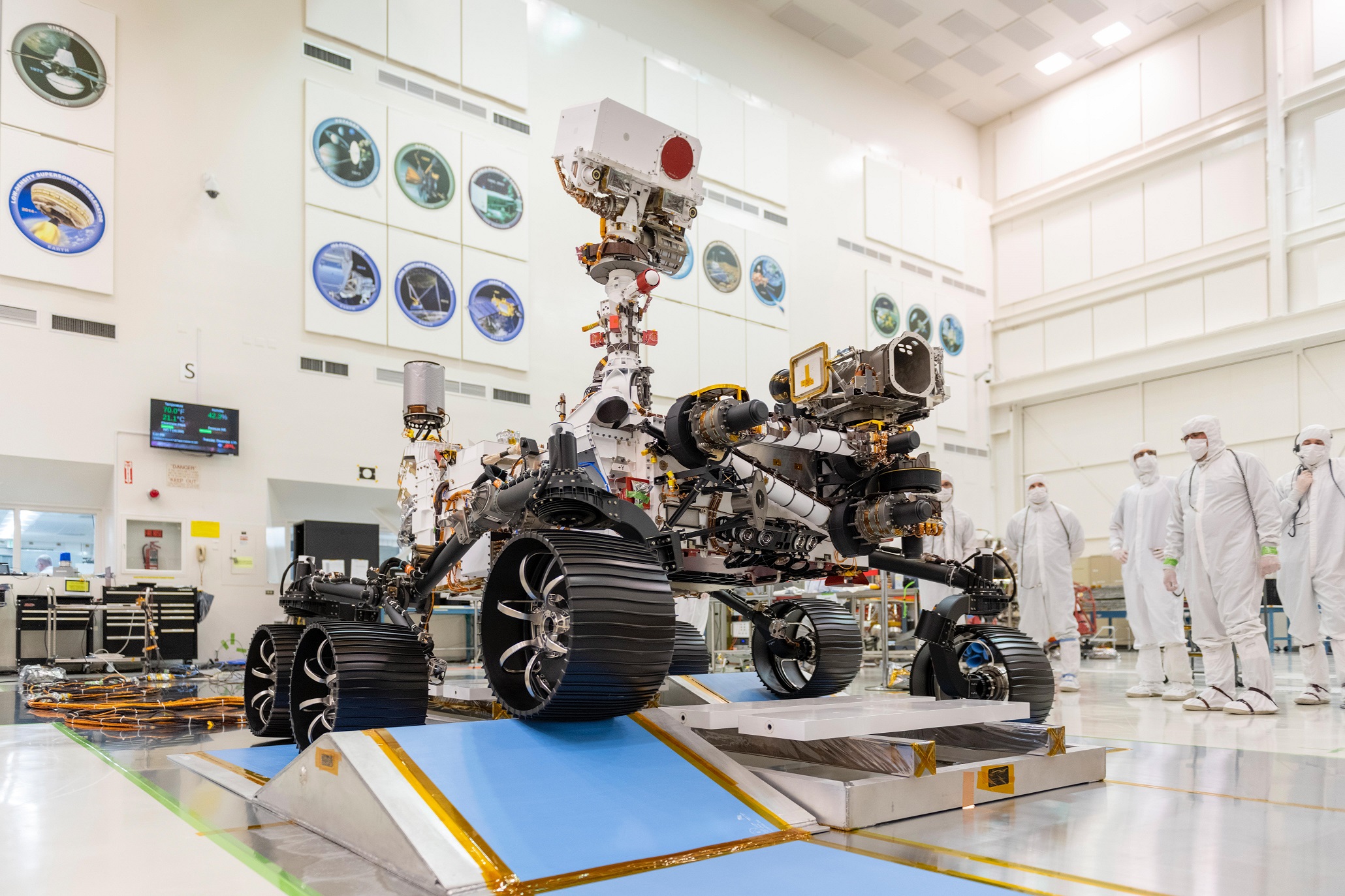
But before the helicopter can help us see Mars in a whole new way, it has to launch. To do so, it will hitch a ride to the red planet attached to the Mars Perseverance rover. The duo is scheduled to launch sometime in July atop a United Launch Alliance Atlas V rocket.
While the helicopter acts as a scout, Perseverance will search for signs of life on the red planet. It will also help scientists characterize the planet’s climate and geology, and ultimately collect samples for future return to Earth. Some of its on board instruments will test out technologies that will help pave the way for eventual human missions to Mars.
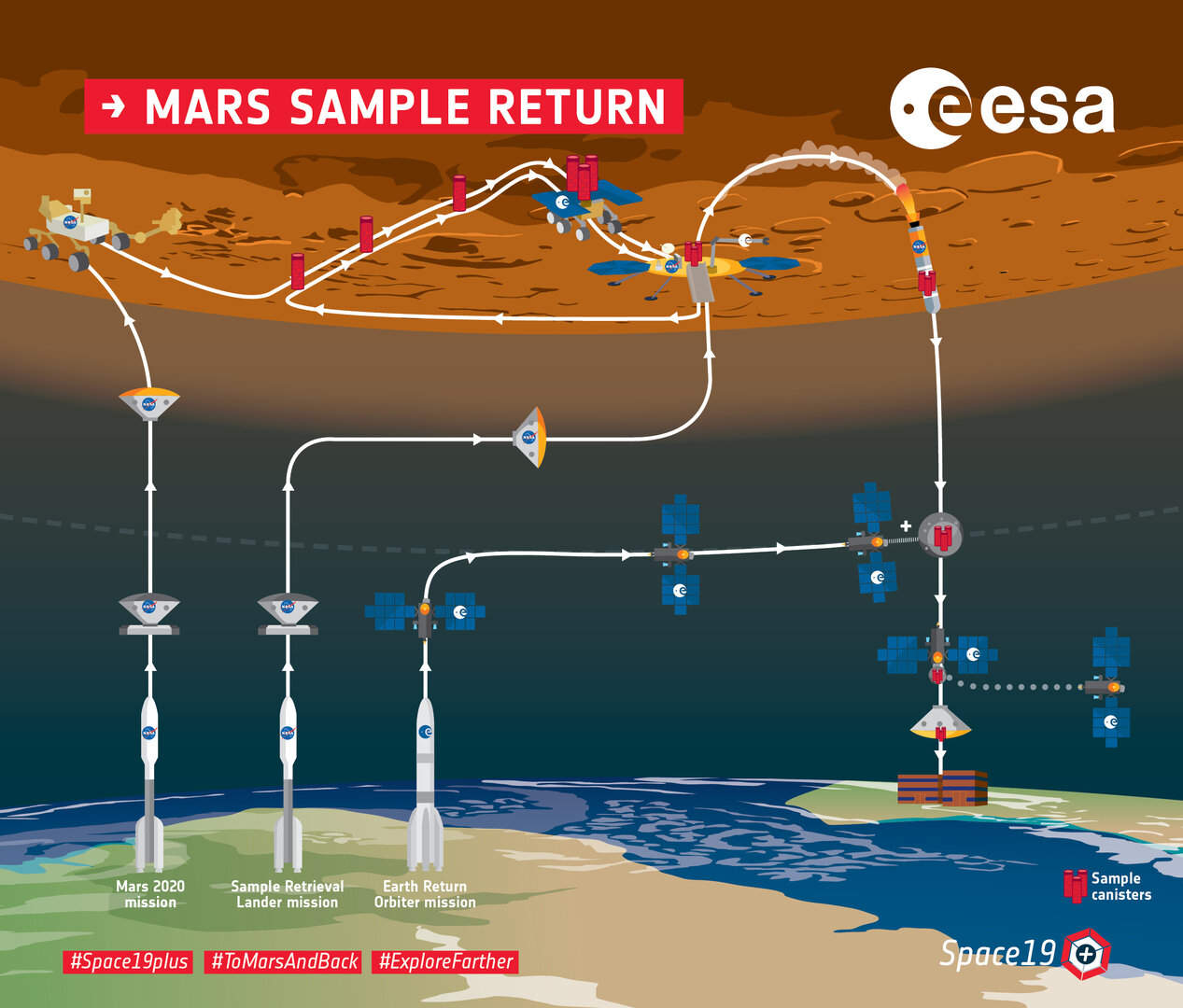
NASA is working with the European Space Agency (ESA)to develop a plan on how best to return the Martian samples to Earth. Sample-return missions are estimated for the mid-2020s. ESA was also working with the Russian Space Agency to send its over rover to Mars, but unfortunately, delays in parachute testing coupled with the coronavirus outbreak, has sidelined that mission until 2022.
As of now, NASA does not foresee any delays to the Perseverance Mars mission. The agency is taking steps to keep its workers safe while also prioritizing this mission as well as any crewed missions to the space station. If all goes as planned, the rover (and helicopter) will arrive on the red planet in February 2021.
Quelle: TESLARATI
+++
NASA's Perseverance Mars Rover Gets Its Wheels and Air Brakes

This wheel, and five others just like it, heads to Mars on NASA's Perseverance rover this summer. Wrapped in a protective antistatic foil that will be removed before launch, the wheel is 20.7 inches (52.6 centimeters) in diameter. The image was taken on March 30, 2020, at NASA's Kennedy Space Center.
After the rover was shipped from JPL to Kennedy Space Center, the team is getting closer to finalizing the spacecraft for launch later this summer.
Final assembly and testing of NASA's Perseverance rover continues at Kennedy Space Center in Florida as the July launch window approaches. In some of the last steps required prior to stacking the spacecraft components in the configuration they'll be in atop the Atlas V rocket, the rover's wheels and parachute have been installed.
Perseverance received its six flight wheels on March 30, 2020. While the rover took a test drive last December, it was on "flight spares" that wouldn't be making the trip to Mars. Designed for the kind of off-roading Perseverance will perform on the Red Planet, the wheels are re-engineered versions of the ones NASA's Curiosity has been using on its traverses of Mount Sharp.

Illustrated here, the aluminum wheels of NASA's Curiosity (left) and Perseverance rovers. Slightly larger in diameter and narrower, 20.7 inches (52.6 centimeters) versus 20 inches (50.8 centimeters), Perseverance's wheels have twice as many treads, and are gently curved instead of chevron-patterned. Credit: NASA/JPL-Caltech
+Larger view
Machined out of a block of flight-grade aluminum and equipped with titanium spokes, each wheel is slightly larger in diameter and narrower than Curiosity's, with skins that are almost a millimeter thicker. They also feature new treads, or grousers: In place of Curiosity's 24 chevron-pattern treads are 48 gently curved ones. Extensive testing in the Mars Yard at NASA's Jet Propulsion Laboratory, which built the rover and manages operations, has shown these treads better withstand the pressure from sharp rocks and grip just as well or better than Curiosity's when driving on sand.
The Parachute
The job of adding Perseverance's parachute to the back shell, where the rover will be stowed on the journey to the Red Planet, took several days and was finished on March 26. Tasked with slowing the heaviest payload in the history of Mars exploration from Mach 1.7 to about 200 mph (320 kph) during the rover's landing on Feb., 18, 2021, the 194 pounds (88 kilograms) of nylon, Technora and Kevlar fibers are packed so tightly into a 20-inch-wide (50-centimeter-wide) aluminum cylinder that it is as dense as oak wood. When deployed at about 7 miles (11 kilometers) above the Martian surface, the chute will take about a half-second to fully inflate its 70.5-foot-wide (21.5-meter-wide) canopy.
The Perseverance rover is a robotic scientist weighing 2,260 pounds (1,025 kilograms). It will search for signs of past microbial life, characterize the planet's climate and geology, collect samples for future return to Earth, and pave the way for human exploration of the Red Planet. No matter what day Perseverance launches during its July 17-Aug. 5 launch period, it will land on Mars' Jezero Crater on Feb. 18, 2021.
Perseverance is part of a larger program that includes missions to the Moon as a way to prepare for human exploration of the Red Planet. Charged with returning astronauts to the Moon by 2024, NASA will establish a sustained human presence on and around the Moon by 2028 through NASA's Artemis lunar exploration plans.
Quelle: NASA

